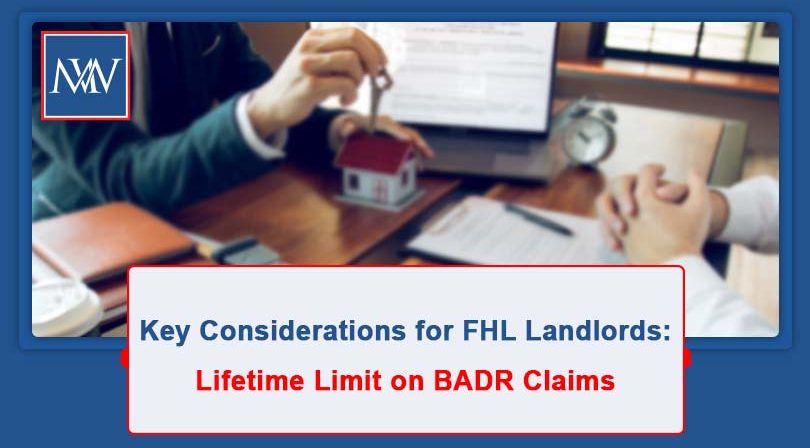
Key Considerations for FHL Landlords: Lifetime Limit on BADR Claims
Landlords with furnished holiday lettings (FHLs) are living in uncertain times. At the 2024 Spring Budget, it was announced that the favorable tax regime for FHLs would be abolished from 6 April 2025. However, the legislation has yet to be enacted, and it remains unclear if it will see the light of day.
Landlords of FHLs enjoy several benefits that are unavailable to landlords letting residential properties on long-term lets, and these include several capital gains tax advantages. A key benefit is the ability to access Business Asset Disposal Relief (BADR), which can reduce the capital gains tax payable on the gain to 10%, regardless of whether income and gains exceed the basic rate band.
With a possible end to the FHL regime looming, landlords may decide it is safer to sell their FHLs before 6 April 2025 to access the existing reliefs, particularly if they are sitting on a substantial capital gain. Landlords attempting to beat the system should note that it was announced that anti-forestalling provisions would apply to landlords who enter into unconditional contracts on or after 6 March 2024 (the date of the Spring Budget).
Nature of BADR
Business Asset Disposal Relief (previously known as Entrepreneurs’ Relief) reduces the amount of capital gains tax payable on the disposal of a qualifying business asset, as long as the qualifying conditions are met for the two years to the date that the business ceased or the asset was sold.
The relief is only available on the disposal of a business asset where there is a disposal of the whole or part of the business. If the property is disposed of after the business ceased, the disposal must take place within three years of the date of cessation. From a practical perspective, this allows the landlord to stop letting the property as an FHL while it is on the market.
If the landlord only has one FHL, the business will cease if the property is sold and, as long as the qualifying conditions are met, BADR should be available. Where a landlord has more than one FHL, the position is more complicated as there must be a disposal of part of the business to access the relief – relief is not available for the disposal of an asset by a continuing business. However, disposing of one property within an FHL business will result in the disposal of the part of the business associated with that property, so BADR should be forthcoming.
Amount of relief and lifetime limit
Where BADR is available, capital gains tax is charged at the rate of 10%. This can generate significant savings. For example, if a landlord makes a chargeable gain on an FHL of £200,000 and the landlord is a higher-rate taxpayer, a capital gains tax of £20,000 will be payable. However, the same gain on the sale of a residential property where BADR is not available will trigger a tax bill of £48,000 (2024/25 rate).
However, BADR is subject to a lifetime limit of £1 million. Once relief has been granted on gains of £1 million, normal capital gains tax rates apply.
Before deciding on whether to sell one or more FHLs to benefit from the 10% rate, landlords should consider the availability of the lifetime limit, and ensure that it remains available to cover the expected gains. Any gains realized in the past on which BADR has been claimed must be taken into account.
The limit applies to the individual, not to the type of gain, and all gains attracting BADR (not just those relating to FHLs) must be taken into account. This may include gains on the disposal of shares in a personal company or the disposal of assets on the cessation of trade.
Partner note: TCGA 1992, Pt. V, Ch. 3; ITTOIA 2005, Pt. 3, Ch. 6.
For more information, Book a Free Consultation
Need Accountancy Support?
For information on bespoke training, or if you have any other questions for Makesworth Accountant, please fill in your details below
















 151
151